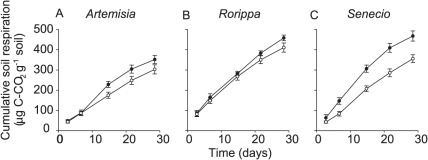I am a science student, however unfortunately a complete newbie in math and statistics. I am measuring soil respiration for my master thesis project and have a certain amount of carbon respired that I have measured over 30 day period. I plotted the respired carbon as a function of time in days and it looks similar to this:

Each data point is a sum of the measured value at a certain day plus value of the previous measurement at a certain day (time). Now, I know how to calculate and report error bars for a basic data, but these are sums of values (cumulative values), so I am wondering how to estimate standard error or deviation for this type of data. How would I calculate and report error bars for my data in this situation?
P.S. This graph is just an example, not my actual data, but it is essentially the same.
